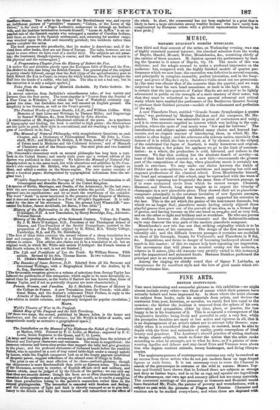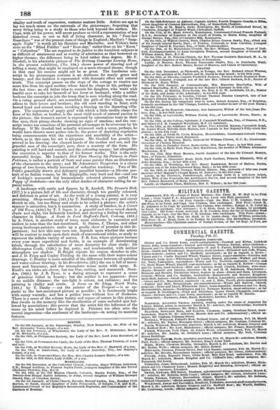FINE ARTS.
BRITISH INSTITUTION.
THE most interesting and successful pker.nres in this exhibition—we reiglat almost include every other—are those of scenes which their painters have actually beheld and been impressed by. In those where the artist chooses his subject from books, oulls his materials from prints, and derives the, sentiment from poet, historian, or novelist, we rarely find him equal to the occasion: the farther the incident is removed from the sphere of his own observation and sympathies, either by time, place, or passion, the less happy is he in his treatment of it. This is so natural a consequence of the imaginative faculties being lively and powerful in only a very few, while the perceptive faculties are more or less active and vigorous in all, that it is no disparagement of an artist's talent not to attempt lofty themes; espe- cially when it is considered that the painter, to succeed, must be able to depict with the force and animation of reality, poetic conceptions of ideal beauty and grandeur. The Academy's absurd practice of setting students to design classic subjects, tends to foster the notion that the artist ranks according to what he attempts, not to what he does; as if a painter of shoe- wearing Apollos and Adams and. stay-laced Eves and Venuses were above him who depicts sentient animals, sunny landscapes, and living idiosyrt- eracies.
The unpkturesqueness of contemporary costume can only be received an an excuse from those artists who do not put modern faces on toga-draped figures or nude forms. It is not necessary even to cross the Channel in search of the picturesque in costume or the -wild in nature: Messrs. Tope ham and Goodall have shown that in Ireland there are subjects as strange and dirty as Italian boys; and in so far as rags and squalor are ingredients of the picturesque, our own age and country afford but too many materials- The nocturnal meetings of the peasantry at Goatacre and Bremhill would. have furnished Mr. Poole, the painter of poverty and wretchedness, with a subject to pair with his pictures of Plague and Famine. Character and emotion are to be studied everywhere; and when these are tlepiesed wia vitality and truth of expression, costume matters little. Artists are apt to lay too much stress on the externals of the picturesque; forgetting that
every living being is a study to those who look beyond the surface. Mr.
Cope, with all his power, will never produce so vivid a representation of any historical event, or one so full of living character, as his "Poor-law Guardians" was of the present state of things in England; Maclise's "Snap- apple Night" is worth all his Hamlets and Macbeths; and Wilkie's fame rests on his "Blind Fiddler" and "Rent-day," rather than on his " Knox " or" Columbus." The art required to do justice to the humblest subjects is as difficult of attainment and as worthy of admiration as that bestowed on higher themes; the difference being in kind rather than degree. Mr. F. Goodall, in his admirable picture of The Brittany Conscript Leaving Home, in the present exhibition, (No. 134) shows power of drawing and of telling a story, that might be employed on a more elevated theme; though in that case his success might not be so great. The handsome con- script in his picturesque costume is an Antinous for manly grace and beauty; and the incident is represented with dramatic effect and natural truth. The conscript pauses on the steps of the cottage to receive one more kiss from his aged mother, whose hand he clasps in his, perhaps for the last time: an old father tries to console his daughter, who waits with tearful eyes to take her farewell of her lover or husband; while a soldier beckons the conscript to join the troop that is seen winding along the road. On a rising ground above, are assembled the girls of the village, waving adieus to their lovers and brothers; the old cure standing in front, with bowed head and crossed arms, invoking a blessing on the departing villa- gers. The expression of angry grief with which a little urchin clasps the knee of his father, or brother, is the most vivid touch of natural passion in the picture: the women's sorrow is expressed by ostentatious tears in their fine eyes, their plump cheeks showing no signs of emotion; and the con- script seems too conscious of his personal advantages to be overcome by his feelings. If Mr. Goodall had actually witnessed such a scene, perhaps, he would have thrown more pathos into it; the power of depicting expression being commensurate with the experience and sensibility of the artist- where, as in this case, his art is adequate. Mr. Goodall has greatly im- proved in his drawing: the clasped hands of the mother and son, and the graceful ease of the conscript's pose, show a mastery of the form. His painting is still hard and smooth, and the colouring opaque; but altogether, the execution is superior to that of his former works. This is the only successful design. Mr. Lauder's Dick Tinto Showing his Pictures to Peter Pattieson, is rather a portrait of Scott and some painter than an illustration of the characters in the story; and Mr Johnstone's Temptation is a clever group of two lovers wholly innocent of seductive tendency. Two of Mr. Frith's gracefully drawn and delicately pencilled beauties-a life-size por- trait of an Italian woman, by Mr. Rippingille, very hard and flat-and one of Inskipp's mannered but harmoniously coloured pictures, called The Poppy of Andalusia-are the only other studies of character calling for es- pecial notice.
A. landscape with cattle and figures, by B. Ansdell, The Drover's Halt, (217,) is a picture full of life and character, though too gaudily coloured, and deficient in point of art. As the work of a young painter, it is very promising. Sheep-washing, (161,) by T. Boddington, is a pretty and clever sketch in oils, but too flimsy and crude to be called a picture: the artist's mariner is attractive, but it is mannerism. A study of beeches, in A Covert of Old Trees, (450,) by T. J. Soper, is a graceful and silver-toned sketch, crude and slight, but delicately touched, and showing a feeling for natural character in foliage. A Scene its Lord Stafford's Park, Costessy, (461,) by A. Priest, is another study of trees, more elaborate in execution and mellow in tone than the last-mentioned. G. Simms, J. Thorpe, and other young landscape-painters, make up a goodly show of promise in this de- partment; but how this may turn out, depends upon whether the artists Will be content to trade upon their stock of conventional tricks, or study to represent the infinite variety of nature. F. R. Lee, whose pictures become every year more superficial and feeble, is an example of deteriorating talent, through the substitution of mere dexterity for close study: his Okehampton Castle, (129) is flat, petty, and insubstantial, with neither atmosphere nor shadow. H. Bright repeats his crayon sketches in oils; and J. D. Fripp and Copley Fielding do the same with their water-colour drawings. C. Bentley is more mindful of the difference between oil-painting and water-colour drawing: in his Broadstairs, (23,) the sea is full of move- ment and buoyancy, and the atmosphere seems moist with spray. R. Knell's sea views are clever, but too blue, cutting, and mannered. Snow- don, (360) by J. B. Pyne, is a daring attempt to represent a scene of grandeur veiled in beauty; but the artifice is too apparent: there is no middle distance; the sun-light is colour, not radiance; and the painting is chalky and crude. A Scene on the Llugy, North Wales, (181,) by T. Danby - not the painter of the Tempest-is as op- posite to the last-mentioned picture as possible: it is luminously bright with sunny warmth; and has a golden tone without loss of freshness. There is a sense of the solemn beauty and repose of nature in this picture, that dwells in the memory like the recollection of some secluded spot hal- lowed by associations: this proves that the artist felt the influence of the scene on his mind before he depicted it. Painters too often miss the mental impression-the sentiment of the landscape-in noting its material features.



























 Previous page
Previous page